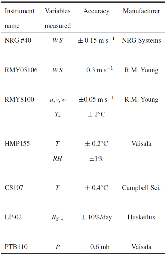Coastal Wind and Turbulence Observations during the Morning and Evening Transitions over Tropical Terrain
Abstract
Data collected during a multiyear, wind-resource assessment over a multi-land-use coastal environment in Belize are used to study the development and decay of wind and turbulence through the morning and evening transitions. Observations were made on three tall masts, forming an inland transect of approximately 5 km. The wind distribution is found to be bimodal and governed by synoptic scales, with onshore and offshore flow regimes. The behavior between the coastal and inland sites is found to be very similar when the flow is directed offshore; for onshore flow, stark differences occur. The mean wind speed at the coastal site is approximately 20% greater than the most inland site and is nearly constant throughout the diurnal cycle. Furthermore, for both flow regimes, the influence of the land–sea breeze circulation is inconsequential relative to the large-scale synoptic forcing. Composite time series are used to study the evolution of sensible heat flux and turbulence kinetic energy (TKE) throughout the morning and evening transitions. The TKE budget reveals that at the coastal site mechanical production of TKE is much more important than buoyant production. This allows for the unexpected case in which TKE increases through the ET despite the decrease of buoyant TKEmore »
- Authors:
-
- Lawrence Livermore National Laboratory, Livermore, California
- Department of Mechanical Engineering, University of Utah, Salt Lake City, Utah
- Department of Civil and Water Engineering, Université Laval, Quebec City, Quebec, Canada
- Washakie Renewable Energy, Salt Lake City, Utah
- Publication Date:
- Research Org.:
- Lawrence Livermore National Lab. (LLNL), Livermore, CA (United States)
- Sponsoring Org.:
- USDOE
- OSTI Identifier:
- 1413572
- Alternate Identifier(s):
- OSTI ID: 1417277
- Report Number(s):
- LLNL-JRNL-727607
Journal ID: ISSN 1558-8424
- Grant/Contract Number:
- AC52-07NA27344
- Resource Type:
- Published Article
- Journal Name:
- Journal of Applied Meteorology and Climatology
- Additional Journal Information:
- Journal Name: Journal of Applied Meteorology and Climatology Journal Volume: 56 Journal Issue: 12; Journal ID: ISSN 1558-8424
- Publisher:
- American Meteorological Society
- Country of Publication:
- United States
- Language:
- English
- Subject:
- 58 GEOSCIENCES; 17 WIND ENERGY; complex terrain; atmosphere-land interaction; coastal flows; turbulence; diurnal effects; budgets
Citation Formats
Jensen, Derek D., Price, Timothy A., Nadeau, Daniel F., Kingston, Jacob, and Pardyjak, Eric R. Coastal Wind and Turbulence Observations during the Morning and Evening Transitions over Tropical Terrain. United States: N. p., 2017.
Web. doi:10.1175/JAMC-D-17-0077.1.
Jensen, Derek D., Price, Timothy A., Nadeau, Daniel F., Kingston, Jacob, & Pardyjak, Eric R. Coastal Wind and Turbulence Observations during the Morning and Evening Transitions over Tropical Terrain. United States. https://doi.org/10.1175/JAMC-D-17-0077.1
Jensen, Derek D., Price, Timothy A., Nadeau, Daniel F., Kingston, Jacob, and Pardyjak, Eric R. Fri .
"Coastal Wind and Turbulence Observations during the Morning and Evening Transitions over Tropical Terrain". United States. https://doi.org/10.1175/JAMC-D-17-0077.1.
@article{osti_1413572,
title = {Coastal Wind and Turbulence Observations during the Morning and Evening Transitions over Tropical Terrain},
author = {Jensen, Derek D. and Price, Timothy A. and Nadeau, Daniel F. and Kingston, Jacob and Pardyjak, Eric R.},
abstractNote = {Data collected during a multiyear, wind-resource assessment over a multi-land-use coastal environment in Belize are used to study the development and decay of wind and turbulence through the morning and evening transitions. Observations were made on three tall masts, forming an inland transect of approximately 5 km. The wind distribution is found to be bimodal and governed by synoptic scales, with onshore and offshore flow regimes. The behavior between the coastal and inland sites is found to be very similar when the flow is directed offshore; for onshore flow, stark differences occur. The mean wind speed at the coastal site is approximately 20% greater than the most inland site and is nearly constant throughout the diurnal cycle. Furthermore, for both flow regimes, the influence of the land–sea breeze circulation is inconsequential relative to the large-scale synoptic forcing. Composite time series are used to study the evolution of sensible heat flux and turbulence kinetic energy (TKE) throughout the morning and evening transitions. The TKE budget reveals that at the coastal site mechanical production of TKE is much more important than buoyant production. This allows for the unexpected case in which TKE increases through the ET despite the decrease of buoyant TKE production. Multiresolution flux decomposition is used to further study this phenomenon as well as the evolution of the sensible heat flux at differing time scales. We present an idealized schematic to illustrate the timing and structure of the morning and evening transitions for an inland site and a coastal site that are subjected to similar synoptic forcing.},
doi = {10.1175/JAMC-D-17-0077.1},
journal = {Journal of Applied Meteorology and Climatology},
number = 12,
volume = 56,
place = {United States},
year = {Fri Dec 15 00:00:00 EST 2017},
month = {Fri Dec 15 00:00:00 EST 2017}
}
https://doi.org/10.1175/JAMC-D-17-0077.1
Web of Science
Figures / Tables:
 Table 1: Instrumentation deployed during the 30-month field campaign. See Fig. 3 for instrument locations. WS is wind speed; u, v and w are the longitudinal, transverse and vertical wind speed, respectively; Ts is the sonic derived temperature and is approximately equal to virtual temperature; T is air temperature; RHmore »
Table 1: Instrumentation deployed during the 30-month field campaign. See Fig. 3 for instrument locations. WS is wind speed; u, v and w are the longitudinal, transverse and vertical wind speed, respectively; Ts is the sonic derived temperature and is approximately equal to virtual temperature; T is air temperature; RHmore »
Figures / Tables found in this record:

 Search WorldCat to find libraries that may hold this journal
Search WorldCat to find libraries that may hold this journal